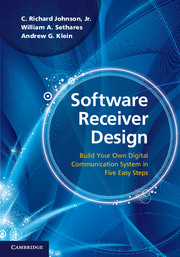Book contents
- Frontmatter
- To the Instructor …
- Contents
- Dedication
- Step 1 The Big Picture
- Step 2 The Basic Components
- Step 3 The Idealized System
- Step 4 The Adaptive Components
- 10 Carrier Recovery
- 11 Pulse Shaping and Receive Filtering
- 12 Timing Recovery
- 13 Linear Equalization
- 14 Coding
- Step 5 Putting It All Together
- Appendices
- Index
- References
12 - Timing Recovery
from Step 4 - The Adaptive Components
Published online by Cambridge University Press: 05 June 2012
- Frontmatter
- To the Instructor …
- Contents
- Dedication
- Step 1 The Big Picture
- Step 2 The Basic Components
- Step 3 The Idealized System
- Step 4 The Adaptive Components
- 10 Carrier Recovery
- 11 Pulse Shaping and Receive Filtering
- 12 Timing Recovery
- 13 Linear Equalization
- 14 Coding
- Step 5 Putting It All Together
- Appendices
- Index
- References
Summary
When the signal arrives at the receiver, it is a complicated analog waveform that must be sampled in order to eventually recover the transmitted message. The timing-offset experiments of Section 9.4.5 showed that one kind of “stuff” that can “happen” to the received signal is that the samples might inadvertently be taken at inopportune moments. When this happens, the “eye” becomes “closed” and the symbols are incorrectly decoded. Thus there needs to be a way to determine when to take the samples at the receiver. In accordance with the basic system architecture of Chapter 2, this chapter focuses on baseband methods of timing recovery (also called clock recovery). The problem is approached in a familiar way: find performance functions that have their maximum (or minimum) at the optimal point (i.e., at the correct sampling instants when the eye is open widest). These performance functions are then used to define adaptive elements that iteratively estimate the sampling times. As usual, all other aspects of the system are presumed to operate flawlessly: the up and down conversions are ideal, there are no interferers, and the channel is benign.
The discussion of timing recovery begins in Section 12.1 by showing how a sampled version of the received signal x[k] can be written as a function of the timing parameter τ, which dictates when to take samples. Section 12.2 gives several examples that motivate several different possible performance functions, (functions of x[k]), which lead to “different” methods of timing recovery.
Information
- Type
- Chapter
- Information
- Software Receiver DesignBuild your Own Digital Communication System in Five Easy Steps, pp. 250 - 269Publisher: Cambridge University PressPrint publication year: 2011
